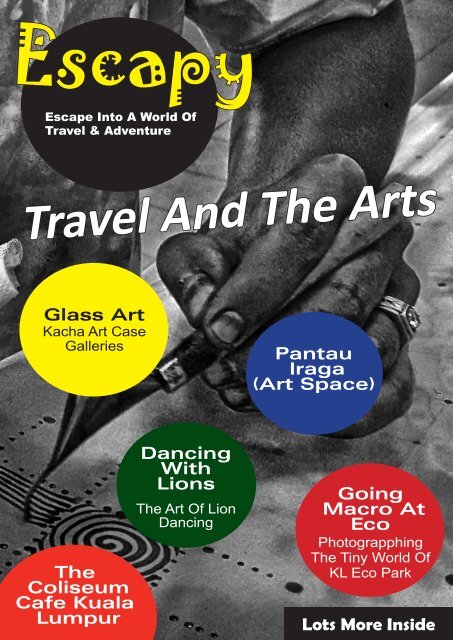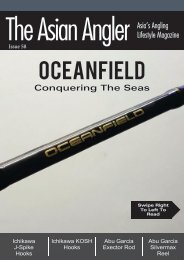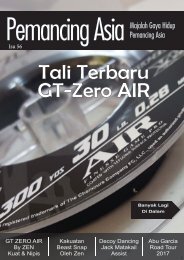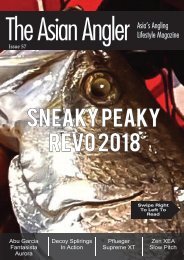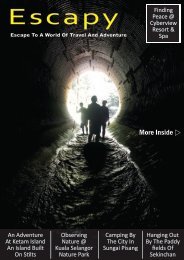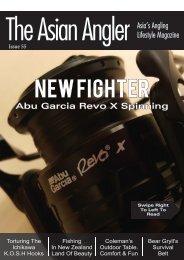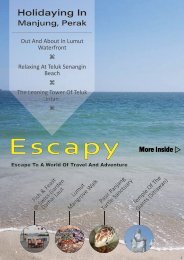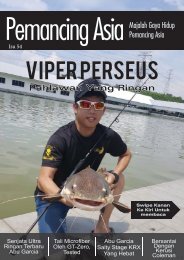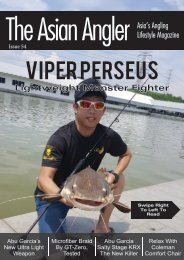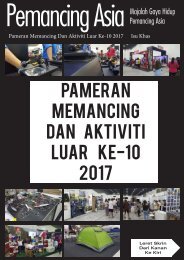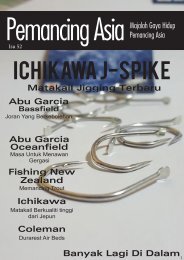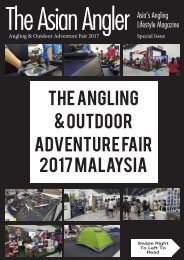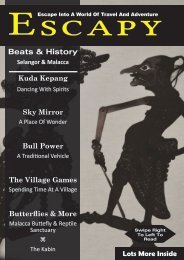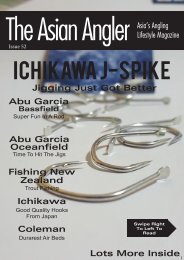You also want an ePaper? Increase the reach of your titles
YUMPU automatically turns print PDFs into web optimized ePapers that Google loves.
<strong>Escapy</strong><br />
Escape Into A World Of<br />
Travel & Adventure<br />
Travel And The Arts<br />
Glass Art<br />
Kacha Art Case<br />
Galleries<br />
Pantau<br />
Iraga<br />
(Art Space)<br />
The<br />
Coliseum<br />
Cafe Kuala<br />
Lumpur<br />
Dancing<br />
With<br />
Lions<br />
The Art Of Lion<br />
Dancing<br />
Going<br />
Macro At<br />
Eco<br />
Photograpphing<br />
The Tiny World Of<br />
KL Eco Park<br />
Lots More Inside<br />
1
Dear friends,<br />
Welcome to another issue of <strong>Escapy</strong>, your free travel digital<br />
magazine and “Pockezine”; your magazine that is made to<br />
be read on mobile devices.<br />
In this issue we look at the arts and crafts in Selangor travelling into the creative<br />
minds of some of Malaysia’s renown artists from glass art to abstract<br />
paintings to art of lion dance. Who knows maybe in the future art could be a<br />
new category of travel just like how medical has become part of travel in the<br />
form of medical tourism.<br />
We also take a look at the indigenous tribes of Peninsular Malaysia starting<br />
with the Orang Asli Museum (Museum of the Indigenous People) and then<br />
touching a little on each of the tribes. There are a lot more information to be<br />
had but perhaps in future issues.<br />
Well my friends, I wish you plenty of travel and safe travels. Should you have<br />
any feedback do email us at info@theasianpublisher.com.<br />
Thank you for reading <strong>Escapy</strong> and have many, many wonderful adventures.<br />
Cheers,<br />
Phil Foo<br />
Editor In Chief
3<br />
Stone-Mashe<br />
For All Your Office Needs<br />
Stone-Mashe Sdn. Bhd.<br />
L-1-2, Pusat Perdagangan Kuchai,<br />
No. 2, Jalan 1/127,<br />
Off Jalan Kuchai Lama,<br />
58200 Kuala Lumpur.<br />
Contact: 016 202 2635<br />
Email: ann@stone-mashe.com
5<br />
Contents Click To Go Directly To Article<br />
National Craft<br />
Institute, Malaysia<br />
Glass Art<br />
Pantau Iraga<br />
(Art Space)<br />
Page: 6<br />
Wheat Straw Art<br />
Page: 40<br />
Going Macro At The<br />
Eco (Park)<br />
Page: 94<br />
The Coliseum Cafe<br />
Kuala Lumpur<br />
Page: 126<br />
Coleman Compact<br />
Aluminium Flat Fold<br />
Chair<br />
Page: 144<br />
Page: 18<br />
The Making Of<br />
Lions<br />
Page: 46<br />
Legoland Malaysia<br />
Launches Lego<br />
Ninjago The Ride<br />
Page: 104<br />
Lovely Durian Desserts<br />
At The ARCH<br />
Cafe, Kuala Lumpur<br />
Page: 134<br />
Turtle Shell 2.0<br />
Speakers, Abu Garcia<br />
Hip Bag Large<br />
Page: 150<br />
Page: 30<br />
Orang Asli Museum<br />
(Museum Of The<br />
Indigenous People)<br />
Page: 60<br />
Sea Lion Hotel<br />
Kuala Selangor<br />
Page: 112<br />
Coleman Kickback<br />
Chair<br />
Page: 138<br />
STOCKHOLM V2<br />
Card Holder Wallet<br />
Page: 154<br />
To return to this page from the articles, click on this tab<br />
Contents Pagelocated at end page of all articles.
Travel Guide<br />
Philemon Foo<br />
National Craft Institute<br />
(Malaysia)
7<br />
For those with an artistic mind, the Institut Kraf<br />
Negara (National Craft Institute) is one of the<br />
schools to go to to enhanced one’s artistic capabilities.<br />
Malaysia is not new to crafts. For decades Malaysia<br />
has been showcasing crafts and as early as<br />
1967 training in the crafts have been introduced.<br />
> Tools for batik “chanting,“ or drawing of wax borders on<br />
cloth.
The establishing of the National Craft Institute was<br />
approved by the council of ministers in 2001 and<br />
since then students who want to major in the crafts<br />
flocked there to increase their knowledge and to<br />
gain themselves certificates and diplomas.<br />
> Batik painting of flowers.
9<br />
The National Craft Institute offers certificates and<br />
diplomas in six categories and they are batik,<br />
Weaving, Metal, Ceramics, Wood, and Rattan. The<br />
National Craft Institute also provide spaces for students<br />
to showcase and sell their creations at the<br />
grounds of the institute.<br />
> A student weaving thread.
Visiting The Institute<br />
Visitors can visit the National Craft Institute and see<br />
how some of these crafts are made. Former students<br />
who have graduated run stalls or rather huts<br />
showing how their chosen craft is made and visitors<br />
can completed masterpieces from them.<br />
> A demonstration on pottery.
Further Information<br />
Address:<br />
No.1,KM.20 Jalan Ipoh – Rawang, Taman Rekreasi<br />
Templer, 48000 Rawang, Selangor Darul Ehsan,<br />
Malaysia.<br />
Tel: 03 60915322<br />
E-mail: webmaster@ikn.gov.my<br />
Website: www.ikn.gov.my<br />
> Clay head of a green superhero.<br />
11
Wood carving demonstration.
Completed wood carvings.<br />
13
A beautiful box carved out of wood.
A demonstration on weaving a rattan basket.<br />
15
This is what the rattan basket looks like when completed.
Jewellery made of silver.<br />
Contents Page 17
Travel Guide<br />
Philemon Foo<br />
Glass Art
Art comes in many forms from the creative minds<br />
of the artist through to their hands (and feet) and<br />
onto all sorts of canvases. Glass art is art made<br />
substantially or wholly out of glass from various<br />
sculptures to decoration pieces and more.<br />
> A large flower made of glass.<br />
19
The Artist<br />
Glass artists are few and in Malaysia there is one<br />
who is very famous and has a following of collectors<br />
with master pieces commanding very very high prices.<br />
He is Raja Azhar Idris who’s works can be seen<br />
adorning homes of the rich as well as public places<br />
such as the National Heart Institute (Malaysia).
Raja Azhar Idris has always loved drawing and creating<br />
art since young. He used to be a street artist<br />
before heading off to Australia and later gaining a<br />
Degree in Fine Arts at the Victorian College Of The<br />
Art in Melbourne, Australia.<br />
21
His art pieces has since been exhibited in more than<br />
20 galleries in Australia, Paris, Singapore, and Malaysia.<br />
He has also received numerous awards over<br />
the years mainly from Australia.<br />
> A large ceiling decor lamp masterpiece.
23<br />
Delicate Art<br />
Working with glass is not something easy. Creating<br />
art with glass makes it even tougher. Raja Azhar<br />
Idris has had his fair share of accidents while creating<br />
his master pieces. Getting cuts is something<br />
normal. He even had a very deep cut to his leg that<br />
almost reach his bone and needed stitches but that<br />
is all part of his passion.<br />
> Art pieces in his oven.
Art Brings Happiness<br />
Despite the injuries and sometimes, disappointments<br />
(when all the hard work put into the piece<br />
ends up being spoiled in the oven), Raja Azhar Idris<br />
loves his art. He has created many masterpieces<br />
such as called Batik On Glass, Jellyfish, and plenty<br />
more. He has even designed art pieces including<br />
dining ware for royalties.<br />
> These glass plate series was made for the royal family.
25<br />
Teaching His Art<br />
Raja Azhar Idris is one artist who is willing to share<br />
his art. He does classes for anyone interested in<br />
taking up glass art. He has classes for children and<br />
adults at a fee of course. His would like to see more<br />
glass artists in the future.<br />
> Raja Azhar Idris at one of his workstations.
The Gallery<br />
His gallery is Kacha Art Case Galleries Sdn. Bhd.<br />
where he showcases his masterpieces. It certainly<br />
is a lovely place to visit especially if one is into collecting<br />
art. Kacha Art Case Galleries Sdn. Bhd. also<br />
sells glass jewellery designed by Shareena Shahridan<br />
who is Raja Azhar Idris’s wife.<br />
> Glass jewellery by Shareena Shahridan.
One of his more difficult pieces, the sort after Songket<br />
Collection.<br />
27
Contact Details<br />
Kacha Art Case Galleries Sdn. Bhd.<br />
No. 8, Jalan Kelab Ukay 2, Bukit Antarabangsa,<br />
68000 Ampang, Selangor, Malaysia.<br />
Mobile : +6019-311 8804 / +6019-220 9246<br />
Click To Check Out Our<br />
2016 Catalogue<br />
http://coleman.com.my/downloads/coleman-catalogue-2016.pdf
Contents Page 29
Travel Guide<br />
Philemon Foo
31<br />
Art is an expression of the creative side and<br />
some become very successful creating art. One<br />
such artist who has become famous over the years<br />
is Awang Damit Ahmad a Malaysian abstract artist<br />
the founder and owner of Pantau Iraga (Art Space).<br />
> Awang Damit Ahmad working on another masterpiece.
This soft spoken man has certainly accomplished a<br />
lot as an artist. He was once an Associate Professor<br />
at one of the local Malaysian universities (UiTM or<br />
Univesiti Teknologi Mara / Mara University of Technology)<br />
being the head of his faculty.<br />
> Ahmad Damit Awang talking about art.
33<br />
Good Value<br />
His paintings are auctioned in big auction houses<br />
the likes of Sotheby’s, and Christies. With the<br />
most expensive to date being auctioned off at<br />
RM390,000.00 of which was resold by a collector.<br />
He has collectors from Hong Kong, Taiwan, Indonesia,<br />
Singapore, Malaysia, America, Canada, Germany,<br />
etc.
The Beginning...<br />
It all started in the 70s where his love for art took<br />
him around his hometown, Sabah. He learned painting<br />
with various artists then. In 1979 at about 25<br />
years of age he pursue a Diploma in Fine Arts at<br />
UiTM. He was top of his class and graduated in<br />
1983.<br />
In 1985 he completed his first art series called Essence<br />
of Culture, drawing on inspiration from his<br />
childhood and working experience, as well as that of<br />
his father; a fisherman and farmer in Sabah.
Being hungry for knowledge and wanting to go further<br />
in the world of art, Awang Damit Ahmad furthered<br />
his studies at the Catholic University of<br />
America, Washington DC in 1989, pursuing a Masters<br />
in Fine Arts. While in the USA he joined Arlington<br />
Art Group and The Capitol Hill exposing himself<br />
to various aspects of art.<br />
35
He returned to Malaysia 10 years later and worked<br />
on one of his famous series, Marista of which he<br />
completed in 2002. In 2011 he completed another<br />
famous series called Iraga. He is currently working<br />
on a new series and experiments with different sorts<br />
of materials including building materials.<br />
> An art piece inspired by his childhood.
When the Tsunami hit he started doing a painting<br />
about the tsunami. But after about three weeks he<br />
stopped for a year and just could not paint. He could<br />
not think nor could he get inspiration. Because the<br />
tsunami is a powerful force with big waves they<br />
overpower his emotions. He was also saddened by<br />
what happened. He managed to finish his painting<br />
a year later.<br />
37
These days he no longer lectures. He focuses solely<br />
on his art but he receives students from UiTM and<br />
UNIMAS (Universiti Malaysia Sarawak) at his workshop<br />
where they do research as well as their practical.><br />
An art piece inspired by his childhood.
Contents Page 39<br />
Want To Visit?<br />
The Pantau Iraga Art Space Gallery is open to public<br />
but by appointment only. One can get in touch<br />
with him at:<br />
Pantau IRAGA (Art Space)<br />
921, Jalan Tanjung, Sijangkang,<br />
Telok Panglima Garang,<br />
42500 Kuala Langat,<br />
Selangor, Malaysia.<br />
TELEPHONE NO.<br />
019-2275469 (Awang)<br />
017-394 4327 (Dayang Umi’ Atiah)<br />
017-280 4643 (Muhammad Iqbal)<br />
Email: awangiraga56@gmail.com<br />
Email: bangkitaartstudio@gmail.com
Travel Guide<br />
Philemon Foo<br />
Wheat Straw<br />
Art
41<br />
Artists are have the ability to create masterpieces<br />
out of almost anything and Haji mohd Yusuff<br />
Shamsudin has been creating beautiful pictures out<br />
of wheat straws for some 64 years. Now being 88<br />
years of age going 89, Haji mohd Yusuff Shamsudin<br />
is still creating art with his son, Anuar Mohd Yusuff,<br />
carrying on his legacy.<br />
> Village scene made of wheat straw.
Quality Wheat Straw<br />
While straw from any wheat, grass, jute, etc. can<br />
be used; Haji mohd Yusuff Shamsudin uses wheat<br />
straw as it is better in quality. Even wheat straws<br />
from different countries have different quality and<br />
texture. He tried using wheat straws from Bangladesh<br />
and found them unsuitable as it comes with a<br />
hard outer layer and does not stick well. The best<br />
wheat straws are from China of which he prefers.
43<br />
Hard Work<br />
Wheat straw art is hard work. Straws will first need<br />
to be boiled together with colour to infuse them with<br />
various colours. When the straws have dried he will<br />
have to slice them into different shapes and sizes,<br />
and then glue them to his canvases. It takes a lot of<br />
patience to do straw art.
Inspiration<br />
Haji Mohd Yusuff Shamsudin draws inspiration from<br />
the many places he has travelled. Most of his masterpieces<br />
are of sceneries, somewhat like a landscape<br />
photographer’s photos. His masterpieces<br />
mainly of village scenes with paddy fields, beaches,<br />
or rivers, and mountains in the background.<br />
> The masterpiece.
Contents Page 45<br />
Should You Want One<br />
Where To Buy?<br />
Should you be interested in buying his masterpieces<br />
you contact Anuar at:<br />
Straw Pictures<br />
Address: Lot 61 Jalan 11, Selayang Baru, 68100<br />
Batu Caves, Selangor Darul Ehsan, Malaysia<br />
Contact : 0182051578 (Whatsapp: ANUAR)<br />
Email : anuarmy1963@yahoo.com.my
Travel Guide<br />
Philemon Foo<br />
The Making Of<br />
Lions
No this is not a motivation piece nor is it a biology<br />
paper on how lions breed. It is about a Chinese traditional<br />
dance known the world over simply as “lion<br />
dance.” Lion dance originated centuries ago in China<br />
and has been performed ever since all over the<br />
world. This dance form comes with elaborate costumes<br />
including a head (lion’s head).<br />
47
An Art Form<br />
Lion dance in its entirety is an art form. From the designing<br />
of the costumes and the various heads, to<br />
the dance steps and stunts; it is all a form of art. The<br />
lion dancers wear pants that are coordinated with<br />
the design of the lions body. The lion head is painted<br />
with various colours according to traditional dances<br />
as well as more new age colours.<br />
> A colourful lion head.
Dance And Stunts<br />
The lion dance moves or steps all tell a story. The art<br />
here is how well the story is conveyed in coordination<br />
to the music. It has thus become an international<br />
sports now known as Lion Sport (or Lion Dance Sport)<br />
where teams from around the world come together to<br />
out dance each other with various routines of which<br />
includes dangerous stunts, and to convey their story in<br />
the best possible way.<br />
49
World Renown Master<br />
In Malaysia we are blessed to have a world renown<br />
master whose team has won numerous lion dance<br />
competitions locally and internationally. This master<br />
is Master Siow. Master Siow is not only good with<br />
the dance steps, he has also done numerous things<br />
to improve the art of lion dance.<br />
>Master Siow talking about his art.
51<br />
Dance And Stunts<br />
One difficult thing to do is to learn the drums. It may<br />
look easy but as it is the main melody and rhythm<br />
of the dance routine, it is actually quite difficult. Lion<br />
dance masters around the world has been looking<br />
for ways to simplify this and Master Siow has done.<br />
Hs method of teaching is now used in many countries<br />
including China.
Master Siow demonstrating the drums.
Reengineering The Head<br />
Another thing that Master Siow has done is to reengineer<br />
the lion’s head. Traditionally the frame of the<br />
lion heads from China are made of bamboo. Bamboo<br />
tends to break and can be dangerous as they<br />
are sharp. Master Siow decided to use lightweight<br />
aluminium for its mainframe in place of bamboo<br />
eliminating breakage. This also gives the lion head<br />
a more rigid feel of which is better.<br />
> The “skeleton” of the lion’s head. Notice the alumini<br />
um structures.<br />
53
A clearer view of the aluminium sections.
Shot from within the lion’s head.<br />
55
Painting a new head at Master Siow’s workshop.
57<br />
Taking The Art Seriously<br />
Master Siow’s students know how serious Master<br />
Siow takes the art of lion dance and they practise<br />
diligently. There is no fooling around as the stunts<br />
done during the dance routine are dangerous and<br />
can easily land one in the emergency room. Discipline<br />
and commitment to the art are both very important.<br />
> The “skeleton” of the lion’s head. Notice the alumini<br />
um structures.
When Can One See<br />
These Dances?<br />
One will most definitely see lion dances during the<br />
Chinese New Year celebrations. Lion dances are<br />
performed all over the place especially at various<br />
shopping malls, certain tourist areas, certain houses,<br />
etc. as it is said to bring good luck.<br />
> Jumping and leaping from pole to pole. They even fly<br />
over a few poles at once. Thrilling to watch indeed.
A superb performance by Master Siow’s lion dance<br />
troupe.<br />
Contents Page 59
Travel Guide<br />
Philemon Foo<br />
The “Orang Asli”<br />
(Indigenous People)<br />
Museum
The “Orang Asli” Museum or Museum of the Indigenous<br />
People in Gombak is one of those museums<br />
that few find in their tour itinerary but more<br />
tour agencies are bringing visitors there. It is a good<br />
place to discover more about the indigenous people<br />
of the Peninsular Malaysia.<br />
61
Tribes<br />
There are a total of three main tribes living in Peninsular<br />
Malaysia and they are Negrito, Senoi, and Melayu<br />
Proto (Proto Malay). Of these three tribes are<br />
many sub tribes:<br />
Negrito: Kensiu, Kintak, Lanoh, Jahai, Mendriq, and<br />
Bateq.<br />
Senoi: Temiar, Semai, Semoq Beri, Jahut, Mah Meri,<br />
and Che Wong.<br />
Proto Malay: Kuala, Kanaq, Seletar, Jakun, Semelai,<br />
and Temuan.<br />
> Ahmadmiswan Bin Sohiman (Assistant Curator) explain<br />
ing the various indigenous tribes.
63<br />
Preservation Of History<br />
Preservation of history is important and it is no different<br />
for the “Orang Asli.” It was Dr. Baharon Azhar<br />
Bin Raffie’i, the Director General of the Department<br />
of Orang Asli Development (JAKOA) (1969 – 1986),<br />
who kick started the idea of preserving the history<br />
of the “Orang Asli.” It took 6 years and finally on<br />
29th of September 1987, The “Orang Asli” Museum<br />
opened its doors to the public.<br />
> Scaled model of the museum.
Tribes<br />
The “Orang Asli” Museum showcases the past way<br />
of living or rather the heritage of the “Orang Asli.” In<br />
the museum there are some information about the<br />
various “Orang Asli” tribes in Peninsular Malaysia,<br />
how they used to live, some of their tools, etc.<br />
> A contraption to pound paddy used by the indigenous<br />
people.
Also on show are some of the items used during<br />
certain ceremonies, traditional items, etc. There is<br />
also a room that plays a video on the lives of the<br />
“Orang Asli” in the days of old.<br />
>A large fish trap.<br />
65
A scaled version of a dug out boat used by the indig<br />
enous people.
67<br />
Information<br />
Orang Asli Museum Address:<br />
Km 24, Jalan Pahang, Gombak, 53100 Selangor,<br />
Malaysia.<br />
Tel: 03-6187 8786<br />
Web: www.jakoa.gov.my<br />
Opening hours: 9am – 5.50pm daily<br />
closed on Fridays.<br />
> Some musical instruments used during ceremonies.
Indigenous Tribes Of The<br />
Peninsular Malaysia<br />
Many of the indigenous tribes in Malaysia that used<br />
to be nomadic hunters, farmers, etc. living deep in<br />
the forests have been resettled into villages or settlements<br />
closer to modern civilization with the hopes<br />
of providing them with improved living. That said,<br />
there are quite a few of them who prefer their traditional<br />
ways of living and are unable to keep up with<br />
the modern world.<br />
Despite the efforts by the government most of these<br />
indigenous tribes continue to live way below the<br />
general poverty line.
Water jugs made of driedout pumpkin.<br />
69
Negrito Tribe<br />
Kensiu<br />
The Kensiu people live in the suburbs in the Baling<br />
District, in the state of Kedah and to date there<br />
is one Kensiu village in the said district of which is<br />
the Lubuk Legong Village. The Lubuk Legong Village<br />
has been equipped with electrical facilities, water<br />
supply and other infrastructures such as a Town<br />
Hall and a Children’s Counselling Centre. Their main<br />
source of income is a Rubber plantation developed<br />
by RISDA (Rubber Industry Smallholders Development<br />
Authority) in collaboration with the Department<br />
of Orang Asli Development.<br />
There are small pockets of Kensiu people living in<br />
the state of Perak and Kelantan where they share<br />
settlements and socio economic relations with another<br />
tribe called the Kintak. The Kensiu people of<br />
Malaysia are closely related to the Kensiu people of<br />
Thailand and thus cross border movements are a<br />
common thing.
The orang asli are firm believers of spirits and demons.<br />
These wood crafts depicts their beliefs.<br />
71
Kintak<br />
The Kintak people live in the suburbs of the Gerik<br />
district, Hulu Perak, in the state of Perak sharing a<br />
settlement with some from the Kensiu tribe. To date<br />
there is one Kintak Village where the Kintak people<br />
live in houses made of timber and planks, provided<br />
by the Department of Aborigines Affairs.<br />
Lanoh<br />
The Lanoh people lived in the rural parts of the Hulu<br />
Perak district, in the state of Perak. Although majority<br />
of the Lanoh people live in forests to date there<br />
are 3 Lanoh villages. The Lanoh were hunters and<br />
gatherers using the caves within the state of Perak<br />
as shelters during their hunting trips. These days<br />
they have settled down in permanent villages giving<br />
up their nomadic way of life. Charcoal drawings<br />
made by the Lanoh people can still be seen on cave<br />
walls.
Another wood carved demon with chains.<br />
73
Jahai<br />
The Jahai Tribe is the smallest sub tribe in the Negrito<br />
Tribe. They live in the state of Perak and in the<br />
state of Kelantan. In Perak they live at the Hulu Perak<br />
region of which is in Banun, Tiang River, and the<br />
Temenggor Dam. In Kelantan they live at Rual and<br />
Jeli River in Hulu Kelantan.<br />
Most of them live at the banks of estuaries and<br />
lakes. They build their homes using banana stems,<br />
bamboo, and leaves. Their homes are built simple<br />
as many of them still live a nomadic lifestyle as they<br />
move when there is a death, unknown diseases, and<br />
disputes within their village. They also move due to<br />
an increase in the village’s population and the need<br />
for more food or newer food sources.<br />
The Jehai are expert hunters with blowpipes and<br />
poison darts. It is said that Jehai boys enjoy spending<br />
the afternoon practising their blowpipe skill by<br />
shooting darts at tree branches.
A traditional orang asli house (scaled down model).<br />
75
Mendriq<br />
The Mendriq people live in the rural areas in the<br />
state of Kelantan with a village in the district of Gua<br />
Musang. They are believed to be one of the first<br />
groups of people to inhabit the Peninsula. They are<br />
mostly dark-skinned with frizzy-hair with features<br />
resembling Papua New Guinean or east African<br />
people. They are generally shorter than other Malaysians.<br />
Bateq<br />
The Bateq people live in the northern rural areas of<br />
the state of Pahang, the western side of the state of<br />
Terengganu, and the southern side of the state of<br />
Kelantan at a place called Pos Lebir. They primarily<br />
inhabit the Taman Negara National Park and they<br />
are nomadic hunters and gatherers.<br />
The Bateq language belongs to the Eastern Jahaic<br />
sub-branch of Aslian languages which is part of a<br />
wider Mon–Khmer language family with mainly oral<br />
language and few written words written in a modified<br />
Latin alphabets.<br />
To date there are seven villages in the state of Pahang<br />
with five villages in the Lipis district and two villages<br />
in Jerantut. The state of Kelantan has four villages,<br />
while the state of Terengganu has one.
A traditional orang asli house (scaled down model).<br />
77
Senoi Tribe<br />
Temiar<br />
The selection of housing by the Temiar Tribe is at a<br />
location determined by the headman. This is done<br />
by way of spells or dreams. Places that are to be occupied<br />
need to be away from burial grounds, free<br />
from the existence of hardwood such as the Merbau<br />
tree (Intsia bijuga). They also do not make settlements<br />
in marshy areas (water reservoirs) for fear of<br />
ghostly apparitions. The same goes for areas with<br />
waterfalls and big rivers of which are considered unsuitable<br />
for fear that the river princess (falls) that will<br />
cause disturbance to their homes.<br />
They build houses of wood (other than the hardwood)<br />
working together as a village team of builders.<br />
In the early stages of settlement, they build long<br />
houses. After living in the long houses for a seemingly<br />
long time, individual families move to other<br />
sites and built their own homes. The Temiar people<br />
support their families via farming, hunting, and<br />
searching for forest plants.
An adze styled by oragn asli of which were used to fell<br />
trees.<br />
79
Semai<br />
The Semai Tribe lives in scattered groups around<br />
the Titiwangsa Mountain range, from the Centre of<br />
Perak (state of Perak), the south of Perak and to the<br />
west of the state of Pahang. They are the largest<br />
indigenous tribe in Malaysia. A census done back<br />
in 1993 indicated their numbers to be about 42,000<br />
people. As of now there is no new information with<br />
regards to its population numbers.<br />
The Semai tribe live in communities of 60 – 300<br />
people per village. They are led by a headman (“Batin”<br />
in the local language) appointed from amongst<br />
influential people within their group of which are usually<br />
the handlers, the medicine man, and the traditional<br />
leaders.<br />
Semoq Beri<br />
The Semoq Beri Tribe lives around the outskirts of<br />
the state of Pahang and Terengganu. In Pahang<br />
there are 5 villages in the district of Jerantut, 5 villages<br />
in the district of Maran, and 2 villages in the<br />
district of Kuantan. In the state of Terengganu there<br />
is 1 village in district of Hulu Terengganu and 2 villages<br />
in the district of Kemaman.
A plate / bowl made of bamboo.<br />
81
Jahut<br />
The Jahut Tribe lives in the districts of Temerloh<br />
and Jerantut in the state of Pahang. In Temerloh<br />
they live in the areas of Kerdau-Paya Paleng, Paya<br />
Mengkuang, Kuala Krau – Penderas, Mendoi, Seboi,<br />
Pasu, Piau, and Galong. In Jerantut they lived in the<br />
Kiol River and Kekwel (Kol).<br />
They support themselves by searching for rattan<br />
and resin to sell. They are do fishing, hunting, and<br />
farming; the main crops being highland rice, corn,<br />
and tuber.<br />
Mah Meri<br />
Mah Meri of which means “Forest People” (Orang<br />
Hutan), are also known as seamen because they<br />
live near to the sea and work as fishermen. There<br />
is no exact historical evidence of their origins, but<br />
they are believed to have emigrated from the islands<br />
south of the state of Johor to the coastal regions of<br />
the state of Selangor while escaping their enemies.<br />
The Mah Meri community has since undergone a<br />
change in their way of thinking and development as<br />
they mix with other communities.<br />
The Mah Meri tribe is famous for their wood carvings<br />
especially their masks, something that has been<br />
highlighted over and over. This skill of theirs have<br />
made them one of the most known indigenous tribes<br />
in Malaysia.
A smaller traditional orang asli fish trap of which is still<br />
quite big.<br />
83
Che Wong<br />
The Che Wong people live in the outskirts of the<br />
Raub and Temerloh Districts, in the state of Pahang.<br />
The Raub District has 4 villages while the Jerantut<br />
district has 1 village. There are still those who live<br />
deep in the forests where they continue to hunt, fish,<br />
and farm.<br />
The Che Wong people plant rice (hill rice), trade<br />
jungle beans (petai), fruits (durians), and sell rattan<br />
as well as resins as income. They also set traps for<br />
boars, deer, fish, etc.
A plate / bowl made of bamboo.<br />
85
Proto Malay<br />
Kuala<br />
The Kuala people is believed to have originated<br />
from the Riau-Lingga archipelago in areas that are<br />
along the beaches in Sumatera, Indonesia and had<br />
migrated to the areas around the coastal rivers<br />
south of the Johor state. Now they live permanently<br />
in the Batu Pahat and Pontian districts in the state of<br />
Johor. Batu Pahat has 5 villages while Pontian has<br />
4.<br />
Kanaq<br />
The Kanaq tribe is the smallest indigenous tribe in<br />
Malaysia. The Kanaq tribe speak the Kanaq language<br />
of which is one of the languages grouped under<br />
the Austonesian Language family. They live in<br />
the Selangi Village of which is located in the district<br />
of Mawai, Johor. The Orang Kanaq were originally<br />
one of the Sea Gypsy people, from Pulau Sekanak<br />
(Sekanak Island) in the Riau Islands of Indonesia.<br />
They started to migrate to Peninsula Malaysia in<br />
around 1784.
Depiction of orang aslis in Peninsular Malaysia.<br />
87
Seletar<br />
The Seletar people or “Sea Gypsies” are a group of<br />
coastal and marine adventurers who used to live on<br />
boats, on the islands, coastal areas, and on estuaries.<br />
Their livelihood comes from the sea. This lead<br />
to their itinerant lifestyle. However changes in their<br />
socio-economy changed the way they live.<br />
Now, they live in a settlement that is organised and<br />
structured in the Coast of Southern Johor. They still<br />
depend on the sea catching fish but now using modern<br />
equipment. Some of them have decided to not<br />
partake in their traditional profession and have decided<br />
to work at the factories nearby.
Blowpipes and poison dart carriers used by the orang<br />
asli on hunting trips.<br />
89
Semelai<br />
The distribution of settlements of the Semelai tribe<br />
can be found in Central Pahang in areas such as the<br />
Bera Lake, Bera River, Teriang River, Paya Besar,<br />
and Paya Badak as well as the border of Pahang towards<br />
the state of Negeri Sembilan at Serting River,<br />
Lui River, and Ulu Muar. In terms of looks, the Semelai<br />
look similar to the local Malay people.<br />
Temuan<br />
The Temuan tribe lives in these states; Selangor,<br />
Melaka, Pahang, Johor (Muar District), and Negeri<br />
Sembilan. They speak Temuan, an Austronesian language<br />
closely related to Malay. The Temuan Tribe in<br />
Negeri Sembilan practise the “Pepatih” custom (also<br />
known as Lareh Bodi Caniago) of which are customary<br />
laws that originated from the Minangkabau<br />
Highlands in Sumatra, Indonesia. They also follow<br />
the general Temuan customs and traditions as those<br />
practised by the Temuan tribes of other states.
Orang asli craft on sale.<br />
91
Support Our Local<br />
Authors<br />
Check Them Out At A Bookshop Near You
Contents Page 93<br />
Subscribe Today<br />
To Get Free Pockezines & <strong>Digital</strong><br />
Magazines Sent To You Every<br />
Month & Never Miss An <strong>Issue</strong><br />
Again.<br />
Three Titles Monthly:<br />
The Asian Angler, Majalah<br />
Pemancing Asia, And <strong>Escapy</strong><br />
Click To Subscribe
Travel Guide<br />
<strong>Escapy</strong><br />
Going<br />
Macro<br />
At The<br />
Eco
95<br />
The Bukit Nanas (Pineapple Hill) Forest Reserve<br />
is the only green lung in the city of Kuala Lumpur.<br />
It has since been called the KL Eco Park. It is a interesting<br />
place where one can go to and do some<br />
jungle trekking or enjoy a canopy walk. We featured<br />
this park in our last issue.<br />
http://www.theasianpublisher.com/magazine/escapy/issues/2016/08-aug/mobile/index.html#28<br />
Click To<br />
Read
Take Out That Camera And Shoot<br />
There are lots of things to point one’s lens at and<br />
shoot such as birds, plants, flowers, etc. There are<br />
also little things to shoot of which is fun for macro<br />
photographers or those that enjoy shooting little<br />
things.<br />
> The canpy walk.
97<br />
Little Things<br />
Many insects call the KL Eco Park home. They hide<br />
amongst plants, leaves, wood, etc. Insects such as<br />
grasshoppers, certain bees, ants, etc. are a plenty but<br />
one will have to search them out. A keen eye is important.<br />
> A little grasshopper amongst the foliage.
Shooting Water<br />
Another interesting thing to shoot is water. Water<br />
droplets in particular. Should you visit the park in the<br />
morning, chances are pretty good that you will be<br />
able to shoot water droplets. Take note though that<br />
the trails can get a bit muddy and slippery.<br />
> Watrer droplets on a leaf in black and white.
99<br />
Shooting Flora<br />
Being an eco park plants are of course a plenty. There<br />
are ferns, mushrooms, flowers, trees, etc, that one can<br />
point one’s macro lens at and shoot.<br />
> Whilst setting up I took this test shot of some ferns.
Beginners & The Pros<br />
The KL Eco Park is a good place for beginners to<br />
practise and level their skills while the pros will find<br />
it a good place to create art. This only remaining<br />
green lung of Kuala Lumpur certainly is one of the<br />
good places for photogs to visit.<br />
> A little white Woolly Aphid walking slowly on a branch.
101<br />
Things To Bring<br />
Other than your camera and gears do bring along these<br />
things:<br />
Drinking water<br />
Mosquito Repellent<br />
Waterproof bag (should it rain)<br />
Rubber trekking shoes
Do Take Note<br />
Outdoor macro photography is quite challenging especially<br />
since many of your targeted subjects are<br />
always moving. Do be patient with them and respect<br />
the natural environment. As the saying goes “take<br />
nothing but pictures and leave nothing behind but<br />
foot prints.” Happy shooting.<br />
> A gold ant. How cool is that?
A red grasshopper looking insect an its tiny friend.<br />
Contents Page 103
Travel News<br />
Legoland Malaysia<br />
Launches<br />
NinjaGo<br />
The Ride<br />
The First In Asia
105<br />
You can now be part of the NINJAGO ninja<br />
warriors and go on adventures defeating evil helping<br />
Master Wu and his Lego ninjas. NINJAGO<br />
The Ride enables guests to use their hands to throw<br />
virtual lightning bolts, move shockwaves, send ice<br />
soaring and emit fireballs with incredible accuracy.<br />
>Welcome to Legoland Malaysia.
Big Big Big Investment<br />
The over RM40 million ride is a fully immersive 4D darkride<br />
that allows guests to become their favourite characters<br />
and defeat enemies, from snake tribes, ghosts and<br />
skeletons to the Great Devourer under the guidance of<br />
Master Wu; using hand gestures to throw virtual projectiles.<br />
>Master Wu and his ninjas are ready to fight for all things<br />
good. Stellar cast of NINJAGO at the launch of LEGO® NIN<br />
JAGO The Ride.
LEGO® NINJAGO The Ride is experienced in<br />
3D and features effects such as heat, smoke and<br />
wind throughout the adventure, giving guests the<br />
ultimate 4D experience. But the real highlight of the<br />
ride is its hand gesture technology. Manufactured<br />
by Triotech, a global leader in media-based interactive<br />
attractions, the technology enables guests to<br />
do as the ninjas do and launch fireballs, lightning,<br />
shockwaves or ice with hand movements.<br />
>Yg. Bhg. Datuk Seri Mirza Mohammad Taiyab (Director-General,<br />
Tourism Malaysia) & Young Pil-Kim (Interim<br />
General Manager, LEGOLAND Malaysia Resort) test out<br />
the interactive activity, Nya’s Practice, in the brand new<br />
NINJAGO World.<br />
107
Ready For An Adventure<br />
Hi-tech sensors register these movements with great accuracy<br />
and seamlessly launch virtual projectiles towards<br />
the targets on display. Up to four guests sit in each ride<br />
vehicle and are guided through various scenes encountering<br />
villains and challenges. At the end of the quest,<br />
guests can view their individual scores on display.<br />
>Ready for an adventure and all prepared to take out the<br />
baddies.
109<br />
Legoland Malaysia Levels Up<br />
LEGO® NINJAGO The Ride certainly takes the<br />
Resort to the next level and with such an investment<br />
is certainly shows commitment to bring stateof-the-art<br />
play to the region – the way only LEGO-<br />
LAND® can.<br />
>All smiles for the official launch of LEGO® NINJAGO<br />
The Ride.
The four LEGO® NINJAGO characters and Sensei Wu<br />
master the four elements to launch the first LEGO® NIN-<br />
JAGO The Ride in Asia.
Contents Page 111<br />
For More Information<br />
PDF Readers: Click Link To Watch Video<br />
https://www.youtube.com/watch?v=wMRXB1WQiAU<br />
visit LEGOLAND® Malaysia Resort’s official website<br />
at www.legoland.com.my<br />
Contact: +607-597 8888<br />
Stay connected with LEGOLAND Malaysia Resort’s<br />
social handles (Facebook & Twitter) to find out more<br />
on online promotions.
Where to Stay<br />
Philemon Foo<br />
Sea Lion Hotel<br />
Kuala Selangor
When one mentions Kuala Selangor, the first<br />
thing that comes to most Malaysian minds is firefly.<br />
For some reason fireflies have overshadowed the<br />
history of Melawati Hill, its monkeys, the fort, etc.<br />
Probably because fireflies are a unique sort of insect<br />
that emits lights, hence the attraction.<br />
>The reception at the Sea Lion Hotel, Kuala Selangor.<br />
113
Firefly Themed Rooms<br />
One hotel that certainly stands out from the crowd of hotels<br />
there is the Sea Lion Hotel. The Sea Lion Hotel is a<br />
firefly themed boutique hotel that is tastefully decorated<br />
with art pieces, nice furnishing, and little lights on the<br />
ceiling of their rooms that mimic fireflies.<br />
>The ceiling of the rooms look like fireflies. The colours of the<br />
lights changes every few seconds.
115<br />
Room Configurations<br />
The Sea Lion Hotel has 45 rooms of various configuration<br />
from the single rooms to family rooms.<br />
The rooms are tastefully furnished with a mixture of<br />
modern and artistically classic furniture. More important<br />
are the beds that they come with. These<br />
beds are comfortable offering a good night’s rest.<br />
>Well decorated rooms.
Unique Pool<br />
Yes, they have a pool that one can play in. Unlike the<br />
usual dugout swimming pools, this pool is built on the<br />
ground and doubles as a water feature. It has a tiled<br />
seats for one to sit on and just hangout. Children will<br />
certainly enjoy playing in the pool.
117<br />
Facilities<br />
When it comes to facilities and amenities the Sea<br />
Lion Hotel comes with the general facilities offered<br />
by most hotels such as hot water shower, hair dryer,<br />
hot water dispenser (public), free wi-fi, etc. One<br />
thing that helps them standout is that they cater to<br />
the less-abled (wheelchair), something more hotels<br />
should have.<br />
>I love this chair. It is comfortable and it looks good.
Strategic Location<br />
There are a few must visit spots in Kuala Selangor such<br />
as the Melawati Hill where the Melawati fort, Altingsburg<br />
Lighthouse, silver leafed monkeys, museum, etc.<br />
are. About 5 minutes drive away from this area is one<br />
the jetties that takes visitors on eagle feeding trips during<br />
the day and firefly trips at night. All these areas are<br />
a mere five to ten minutes drive away from the Sea Lion<br />
Hotel.<br />
>Silver leafed monkey hanging out on a cannon.
119<br />
The area around the hotel has food outlets and<br />
other shops. The famous seafood restaurants are<br />
about 10 minutes drive away. If you decide not to<br />
drive and do not want to walk much, just beside the<br />
hotel is a restaurant.<br />
>Fireflies shot with slow shutter speed during the fire fly<br />
watching trip.
Personal Experience<br />
I recently visited Kuala Selangor with my family and our<br />
friends. We checked into the Sea Lion Hotel which was<br />
highly recommended by a friend, and the price suited<br />
our budget. Checking in was a breeze and they have<br />
lifts that took us to our floor.<br />
>Tasteful decor.
121<br />
When I thought I could get to the room whip out my<br />
laptop and start working, I ended up taking a nap.<br />
My mistake was lying on the bed (was supposed to<br />
be for only 5 minutes) and ended up snoozing for<br />
an hour. The bed was really comfortable and the<br />
dim firefly effect helped with the shut eye.<br />
>Our room had a balcony.
While I didn’t go into the pool I saw kids enjoying themselves<br />
in it with one parent on the deckchair asleep.<br />
With the sound of waterfalls from water flowing off the<br />
sides into a catchment of which I believe sends it to a filtration<br />
system and back into the pool; resting there must<br />
be therapeutic.<br />
> Kids having fun in the pool. The pool is deeper at the other<br />
end.
123<br />
All in all we certainly enjoyed ourselves and had<br />
a good rest. We didn’t have to rush to the sites as<br />
they were nearby. We had easy access to food and<br />
we love eating. Because of its location and facilities<br />
we had a really relaxing trip. We only wished that<br />
we had booked for a night or two longer.<br />
>Room prices.
Information<br />
Address<br />
Sea Lion Hotel<br />
21 Jalan Seri Temenggung 3,<br />
Taman Seri Temenggung,<br />
45000 Kuala Selangor,<br />
Selangor, Malaysia.<br />
Tel: +603 3289 8121<br />
E-mail: info@sealion.com.my<br />
Website: http://sealion.com.my/ks/
Contents Page 125<br />
Subscribe Today<br />
To Get Free Pockezines & <strong>Digital</strong><br />
Magazines Sent To You Every<br />
Month & Never Miss An <strong>Issue</strong><br />
Again.<br />
Three Titles Monthly:<br />
The Asian Angler, Majalah<br />
Pemancing Asia, And <strong>Escapy</strong><br />
Click To Subscribe
For Foodies<br />
Philemon Foo
One of the oldest restaurants in Kuala Lumpur is<br />
the Coliseum Cafe. It is a restaurant that opened its<br />
doors in 1921 during the colonial era and this year<br />
it turned 95. It used to serve the British as well as<br />
the influential locals back in the day serving colonial<br />
Hainanese cuisine.<br />
127
With the original cafe located on the busy Tuanku<br />
Abdul Rahman Road, Coliseum Cafe is a crowd puller<br />
till this day. Very much of the facade remains the<br />
same of which is a good thing. Personally I like it as<br />
it is like walking back in time and dining back in the<br />
late 70s to the early 80s of which was already historical<br />
back then.<br />
> The bar, still remains the same as in days of old.
129<br />
Favourites<br />
Of course we do not go there just for nostalgia sake<br />
or to soak in the ambiance of an era gone by. The<br />
food there is good especially if you like Hainanese<br />
chicken chop, fish and chips, and my personal favourite;<br />
sizzling tenderloin steak. The sizzling steak<br />
is tender and juicy; bringing me back to the first<br />
steak that I ate... of which was here too. Typing this<br />
article I cannot help but salivate. YUMMY.<br />
> Famous for the Hainanese Chicken Chop.
Fruits skillfully carved. This is certainly an art.
If you visit Malaysia and have a few days to spend in<br />
Kuala Lumpur, give Coliseum Cafe a visit and enjoy the<br />
food. They do have other outlets but I personally prefer<br />
the original.<br />
The Original (HQ)<br />
No. 98-100 & 102, Jalan Tuanku Abdul Rahman<br />
50100 Kuala Lumpur, Malaysia.<br />
Contact: Vivian +603 2692 6270<br />
Plaza 33<br />
Lot PG-02, Plaza 33,1 Jalan Semangat, Section 13<br />
46100 Petaling Jaya, Selangor.<br />
Contact: Sri +603-7932 3228<br />
Mid Valley Shopping Mall<br />
Lower Ground Floor LG216, The Gardens, Mid Valley Mall<br />
Kuala Lumpur, Malaysia<br />
Contact: Fizah +603-2202 0588<br />
Sunway Pyramid Shopping Mall<br />
Lot OB.G.(MS) Oasis Boulevard GF<br />
(Sunway main entrance front of Lion Head)<br />
Contact : Heng +603-5611 1921<br />
131
Support Our Local<br />
Authors<br />
Check Them Out At A Bookshop Near You
Contents Page 133<br />
Subscribe Today<br />
To Get Free Pockezines & <strong>Digital</strong><br />
Magazines Sent To You Every<br />
Month & Never Miss An <strong>Issue</strong><br />
Again.<br />
Three Titles Monthly:<br />
The Asian Angler, Majalah<br />
Pemancing Asia, And <strong>Escapy</strong><br />
Click To Subscribe
For Foodies<br />
<strong>Escapy</strong><br />
Lovely Durian<br />
Desserts At The<br />
ARCH Cafe
135<br />
This here is a special food place for the sweet<br />
toothed durian lover who loves everything durian.<br />
The durian desserts at the ARCH Cafe, Kuala Lumpur<br />
is a must try. The Durian Imperial is a creamy<br />
and sweet durian treat.<br />
> The Durian Imperial served on a golden (coloured)<br />
Platter.
Shaped like a durian with sharp thorns that are<br />
made of cream, plus a chocolate durian stem; the<br />
makers or the designers of this dessert clearly had<br />
only one thing in mind, the king of fruits. So if you<br />
love all things durian just head on down to the Arch<br />
Cafe, Kuala Lumpur.<br />
> Mouth watering dessert.
Contents Page 137<br />
Contact Information<br />
ARCH Cafe<br />
KUALA LUMPUR CITY GALLERY<br />
No. 27, Jalan Raja, Dataran Merdeka, 50050 Kuala<br />
Lumpur, Malaysia<br />
Contact: +6 03 2698 3333<br />
Email: klcg@archcollection.com.my<br />
>While the focus is on the Durian Imperial, the durian<br />
cakes in the background are equally tasty.
Introducin’<br />
Shared: The Asian Angler<br />
Coleman<br />
Kickback<br />
Chair
H igh quality outdoor chairs are some of the<br />
things that Coleman has to offer. One of them is<br />
the Coleman Kickback Chair, a folding chair that<br />
fold compactly and then easily placed into a carrying<br />
bag. This makes a good chair for anglers.<br />
campers, picnickers, etc. who intend to go for a<br />
days out fun fishing at a lake.<br />
139
Lightweight Durability<br />
The Coleman Kickback Chair is lightweight<br />
weighing only 2.4kg. and easy to carry making it<br />
ideal for camping trips, fishing trips, picnics, etc.<br />
It is made using strong and durable fabric that is<br />
tough and high quality strong steel legs that can<br />
take over a hundred kilograms of weight.
It comes with a relaxed type back rest with full support,<br />
a low design so that one can sit with legs out<br />
stretch for better relaxation, and has a large pocket<br />
at the seatback area. There is also a carry handle for<br />
easy carrying when the seat is fully open.<br />
>Handle for easy carrying and a large pocket at the back<br />
rest where the handle is.<br />
141
Summary<br />
The Coleman Kickback Chair certainly is a convenient<br />
and mobile chair for one to use whilst<br />
one enjoys the great outdoors with the family. It<br />
is tough, durable, lightweight, and folds up easily<br />
and can be compactly kept into its carrying<br />
bag for easy carrying as well as storage.<br />
>Good quality fabric for durability.
143
Introducin’ Shared: The Asian Angler<br />
Coleman<br />
Compact Aluminium<br />
Flat Fold Chair
W hen you go out for a fun day of fishing with<br />
your family, do it with some added comfort. You<br />
pack some food, some cold drinks in the cooler,<br />
a mat, etc. in anticipation of a fun day. Do bring<br />
along some chairs for all to sit on, such as the<br />
Coleman Compact Aluminium Flat Fold Chair.<br />
145
Lightweight And Compact<br />
The Coleman Compact Aluminium Flat Fold<br />
Chair is both lightweight and compact making<br />
them easy to carry. Just fold them up and secure<br />
the two bars together of which will not allow<br />
them to reopen. This makes carrying and<br />
transporting them easier. When it comes to storage,<br />
they are easy to store too.
147<br />
Strong And Durable<br />
Coleman Compact Aluminium Flat Fold Chair is made<br />
using tough canvas cloth, and high quality aluminium<br />
that are strong and durable. They can take over<br />
a hundred kilograms of weight. They also sit lower<br />
giving it a better centre of gravity of which translates<br />
to stability.<br />
>Strong and durable fabric.
Wooden Armrest<br />
These chairs come with good quality wooden<br />
armrest that are strong and they look good especially<br />
with natural wood grains. They also give<br />
a certain amount of comfort.
Contents Page<br />
149<br />
Summary<br />
>Handle to hold the<br />
chair in folded position.<br />
Also to make<br />
carrying easier.<br />
The Coleman Compact Aluminium Flat Fold Chair is<br />
certainly good to have when one goes out fishing,<br />
have a picnic, or a barbeque with the family. They<br />
are tough, durable, lightweight, easy to carry, easy<br />
to store, and they are comfortable. Certainly good to<br />
have.<br />
Coleman Concept Store<br />
LG2.137, Sunway Pyramid Shopping Mall<br />
No.3, Jalan PJS 11/15, Bandar Sunway,<br />
47500 Subang Jaya, Selangor, Malaysia.<br />
Tel: 1300 88 8388
Goodies<br />
Shared: The Asian Angler<br />
Turtle Shell 2.0 Speakers<br />
Behold the Turtle Shell® 2.0, Outdoor Tech’s most miraculous<br />
rugged, water resistant Bluetooth Speaker to date.<br />
We wouldn’t say something as clishe as “The best just got<br />
better”... it did though. Based off the popular original Turtle<br />
Shell®, the 2.0 brings more volume, more Hi-Fi audio, more<br />
battery life and a plethora of other feature improvements<br />
over its predecessor.<br />
Video: https://www.youtube.com/watch?v=9Dxnj_ANu24<br />
Site: http://www.outdoortechnology.com/Shop/Turtle-Shell/<br />
Note: May not be available in some markets.
PDF Readers: Click Link To Watch Video<br />
https://www.youtube.com/watch?v=zLVUthj2Z-8<br />
Contents Page<br />
151
Goodies<br />
Shared: The Asian Angler<br />
Abu Garcia Hip Bag Large Bag<br />
Camo w/rain case<br />
Should one be on a fishing trip or out for a walk or on a<br />
sightseeing trip, and one has a need of a little extra carrying<br />
space but not the size of a back pack, the Abu Garcia’s<br />
Fishing Hip Bag Large Bag Camo is a convenient bag that<br />
comes into play.<br />
It is large enough to store lots of essentials such as a point<br />
and shoot cameras, cases for your glasses, wallet, keys,<br />
mobile phones, GPS device, water bottle, maps, compass,<br />
MP3 player, power banks, etc. Well, it can easily store all<br />
of them and more. It comes with a rain cover should it rain<br />
keeping the items inside dry.<br />
Site: www.purefishingmalaysia.com<br />
For more information contact: info@my.purefishing.com<br />
Note: May not be available in some markets.
^Lots of storage spaces and<br />
places to hang things like<br />
carabiners, etc. .<br />
>Bottle holder with insulation<br />
to keep drinks cool longer.<br />
Contents Page 153
Goodies<br />
Shared: The Asian Angler<br />
STOCKHOLM V2 Card Holder Wallet<br />
When out on an adventure be it fishing, travelling, etc.<br />
a water resistant wallet is good to have should we end up<br />
wet. It could be the rains, spray of salty seawater while on<br />
a boat, etc. that gets us wet. With the STOCKHOLM V2<br />
CARBON Card Holder Wallet you do not have to worry as<br />
your cards and cash remain dry.<br />
Another thing to worry about these days are thieves using<br />
RFID devices to steal our data and with the STOCKHOLM<br />
V2 Card Holder Wallet you don’t have to worry anymore.<br />
RFID Safe : protects your cards from fraud<br />
Holds up to 10 credit cards<br />
Designed & made in France, waterproof, metal lock<br />
Genuine Carbon Fiber and polycarbonate<br />
Pattern : Sergé<br />
https://www.ogondesigns.com/en/porte-cartes-v20-aluminium-ogon-designs.php<br />
https://www.ogondesigns.com/en/porte-cartes-v20-aluminium-ogon-designs.php<br />
Note: May not be available in some markets.
PDF Readers: Click Link To Watch Video<br />
https://www.youtube.com/watch?v=lyBBLFs2R6I<br />
Contents Page<br />
155
Welcome To<br />
The Asian Publisher<br />
The Free Mobile Magazine People<br />
Do Checkout Our Other Titles<br />
More At:<br />
www.theasianpublisher.com


